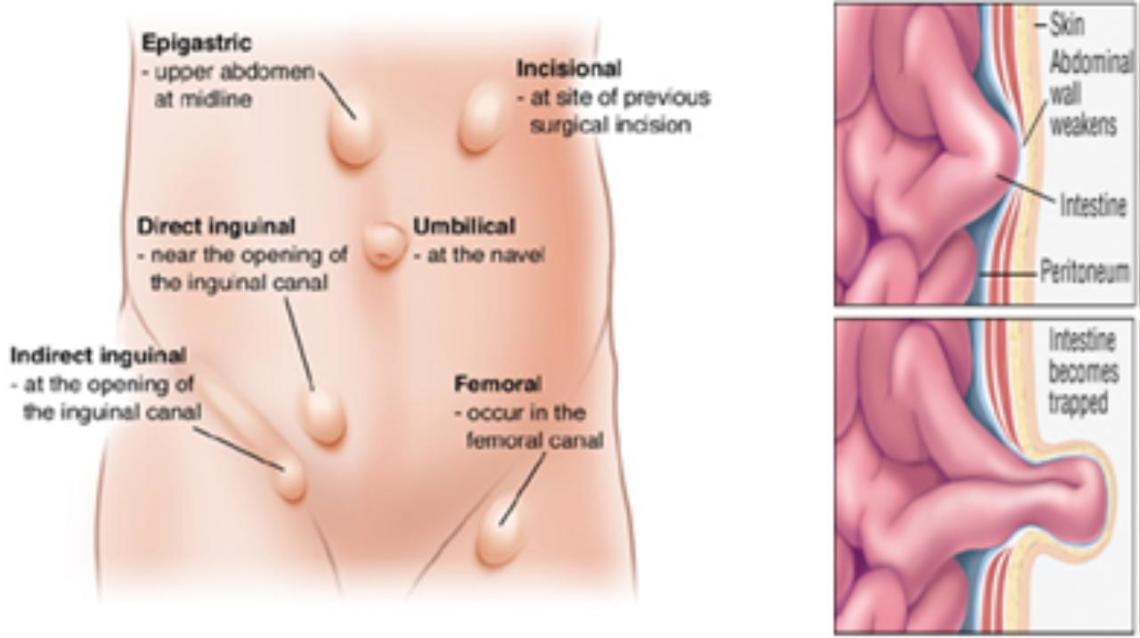Chronic Pancreatitis
October 25, 2017Do I Have Appendicitis? Do I Need Surgery?
October 25, 2017
What is hernia?
It is a weakened spot through which contents of the abdomen come out to lay just below the skin. Usually, there are layers of muscle and sheath covering the intestine. But when weakness occurs for one or the other reason discussed later in the article, then people develop hernia.
Types of Hernia
Incisional hernia
This happens at the site of a previous surgery. This type of hernia is because of incomplete healing at the time of a previous surgery or as a result of some complication, such as infection, of the previous surgery. It has to be noted that 5–10 percent of all patients who had undergone surgery develop this. This is very rare after laparoscopic or keyhole surgery.
Umbilical and paraumbilical hernias
Both these types of hernia occur around an already existing weak spot in the abdomen, that being the umbilicus.
Umbilical hernia can be present at the time of birth, and there is no need to repair it unless it is big. Usually, most of the cases of umbilical hernia resolve by the end of one year. If present beyond 5 years, then surgery is needed.
Paraumbilical hernias are acquired hernias that develop above or below the umbilicus.
Epigastric hernia:
These are hernias appearing in the midline above the umbilicus up to the chest bone.
Inguinal and femoral hernias:
Inguinal hernias are the most common hernias. They are more common in men than in woman.
Femoral hernias appear in the groin below where the inguinal hernias appear. They are more common in elderly females.
Who gets hernias?
People who have conditions that lead to increased abdominal pressure are at a greater risk of developing hernias. Some of the conditions are:
- Persistent coughing
- Being overweight or pregnant
- Lifting, carrying or pushing heavy loads
- Straining on the toilet
What are the symptoms?
Most times, hernias are asymptomatic (no symptoms). People might just notice swelling. The swelling tends to get bigger while standing or doing work and disappear while sleeping. Some might feel a dragging/aching sensation. The swelling tends to get bigger with time.
Symptoms develop when there is a complication such as strangulation. This happens when the contents of the abdomen (intestine) come out and can’t go back. There will be severe pain in the region and vomiting, along with with hard irreducible swelling. The skin might get red. When this happens, you would need surgery within 24 hours to save the stuck intestine. Otherwise, the blood supply to the part of intestine outside the abdomen might get cut off and it might dye (gangrene, requiring resection of that part of the intestine.
How are hernias repaired?
Now a days, most of the hernias are repaired laparoscopically. This means you are in the hospital for only 24 hours. Each type of hernia repair is different and depends on many factors such as the site of the hernia, size of the defect, associated medical conditions, type of hernia, affordability of patients and skill of the surgeon.
In general, laparoscopic hernia repair is costlier as the mesh used needs the side in contact with the intestine to be covered with a special layer. This layer makes sure that the intestines do not stick to the mesh. Then, tackers (screws) are needed to fix the mesh. In addition, the cost of laparoscopic instruments tends to be more than that of instruments used in an open surgery.
Laparoscopic repair has a clear advantage over open repair. Laparoscopy results in less pain, small scars, early return to work and resuming of daily activities. Laparoscopic repair is also associated with less recurrence.
Complications:
About 2 percent of hernias being operated for the first time come back worldwide. (Even if your surgeon does not tell you this, it is a fact. The day when a surgeon can do hernia repair without recurrence he/she will get a Nobel Prize.)
